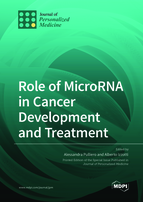Role of MicroRNA in Cancer Development and Treatment
A special issue of Journal of Personalized Medicine (ISSN 2075-4426).
Deadline for manuscript submissions: closed (5 October 2021) | Viewed by 43343
Special Issue Editors
Interests: lung cancer; microRNA; lung cancer microRNA in liquid biopsy
2. Director UOC Mutagenesis and Cancer Prevention, Comprehensive Cancer Center, Genoa, Italy
3. Hospital Policlinico San Martino-IRCCS, Genoa, Italy
Interests: microRNA; genotoxicity; DNA damage; mutagenicity; oxidative stress biomarkers; mutagenesis; antioxidant activity; oxidative stress; DNA repair; apoptosis
Special Issues, Collections and Topics in MDPI journals
Special Issue Information
Dear Colleagues,
Background: Many researchers around the world have demonstrated that the expression of miRNAs is dysregulated in different tumors. Such dysregulation is caused by multiple mechanisms, and exposure to different carcinogens causes dysregulated epigenetic changes and defects in the miRNA biogenesis machinery.
Aim and scope: Cancer cells with abnormal miRNA expression evolve the capability to sustain proliferative signaling, evade growth suppressors, resist cell death, activate invasion and metastasis and induce angiogenesis. Genome-wide profiling demonstrates that miRNA expression signatures are associated with tumor type, tumor grade and clinical outcomes, so miRNAs could be potential candidates for diagnostic biomarkers, prognostic biomarkers, therapeutic targets and preventive screening programs. Although miRNAs have multiple targets, their function in tumorigenesis is due to their regulation of a few specific targets.
History: After the first detection of altered miRNA in leukemia, microRNAs have been demonstrated to be constantly altered in all cancer. More recently, microRNA has been shown to be altered by exposure to environmental carcinogens, thus driving the whole process of carcinogenesis.
Cutting-edge research: Our aim is to provide rigorous peer review and enable rapid publication of cutting-edge research on the role of microRNA in cancer prevention therapy to educate and inspire the scientific community worldwide.
Desired submission types: We welcome research articles, review articles and comprehensive reviews.
Prof. Dr. Alessandra Pulliero
Prof. Dr. Alberto Izzotti
Guest Editors
Manuscript Submission Information
Manuscripts should be submitted online at www.mdpi.com by registering and logging in to this website. Once you are registered, click here to go to the submission form. Manuscripts can be submitted until the deadline. All submissions that pass pre-check are peer-reviewed. Accepted papers will be published continuously in the journal (as soon as accepted) and will be listed together on the special issue website. Research articles, review articles as well as short communications are invited. For planned papers, a title and short abstract (about 100 words) can be sent to the Editorial Office for announcement on this website.
Submitted manuscripts should not have been published previously, nor be under consideration for publication elsewhere (except conference proceedings papers). All manuscripts are thoroughly refereed through a single-blind peer-review process. A guide for authors and other relevant information for submission of manuscripts is available on the Instructions for Authors page. Journal of Personalized Medicine is an international peer-reviewed open access monthly journal published by MDPI.
Please visit the Instructions for Authors page before submitting a manuscript. The Article Processing Charge (APC) for publication in this open access journal is 2600 CHF (Swiss Francs). Submitted papers should be well formatted and use good English. Authors may use MDPI's English editing service prior to publication or during author revisions.
Keywords
- microRNAs
- cancer prevention
- liquid biopsies
- biomarkers
- tumor suppressors or oncogenes
- epigenetic changes and defects in miRNA biogenesis
- altered miRNA expression in tumors
- cancer prognosis








